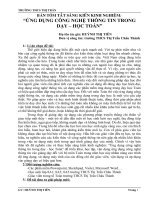Công nghệ vật liệu trong y sinh học biom aterials chapter 2 5
Bạn đang xem bản rút gọn của tài liệu. Xem và tải ngay bản đầy đủ của tài liệu tại đây (1.58 MB, 7 trang )
Chap.2. –
2.10. Surface modification of Biomaterials
SOME IMPORTANT MODIFIED SURFACES
1. Anti-fouling (nonfouling) surfaces (NFSs)
- NFSs refer to surfaces that resist the adsorption of protein and/or adhesion of cells (protein-resistant
surfaces and “stealth” surfaces)
- Generally: hydrophilic surfaces are more likely to resist protein adsorption and hydrophobic surfaces
usually will adsorb a monolayer of tightly adsorbed protein
- NFSs are also important to reduce bacterial bio-films forming which can stimulate significant
inflammatory reaction to the infected devices (in urinary catheters and endotracheal tubes, in vascular
grafts, hip joint prostheses, heart valves and other long-term implants)
.c
om
- Used as blood-compatible materials (where they may resist fibrinogen adsorption and platelet
attachment), implanted devices, urinary catheters, diagnostic assays biosensors, affinity separations,
microchanel flow devices, intravenous syringes and tubing
(It is important to noted that many of these uses involve in vivo implants or extracorporeal devices,
and many others involve in vitro diagnostic assays, sensors…)
- Examples: Blood compatible “PEO-like” films
co
*Usually coated on PET surfaces by plasma deposition
ng
•Surface containing PEG- poly(ethylene glycol) (-CH2CH2-O-)n
n from 2 to 15: oligome ethylene glycol (oEG)
n from 15-3500 (M = 400- 100,000): PEG
n greater than 100,000: PEO - poly(ethylene oxide)
Advanced Program Biomedical Engineering – HUST, Vietnam
ng
th
an
1
du
o
Chap.2. – 2.10. Surface modification of Biomaterials
2. “Teflon-like” films
• Used as Blood-compatible materials, usually coated on Dacron
cu
u
• Composition: CFx (0
Schematic diagrams of “Teflon-like) coating: (A) network structure with variable F/C ratio
(2≥F/C>0), and high cross-linking; (B) ordered chain structure with –CF3 surface groups,
high F/C ratio, very low cross-linking and surface energy
*Preparation by RF plasma deposition of C2F4 in H2 , composition is controlled by changing C2H4/H2 feed
* Very hydrophobic, high protein retention
2
CuuDuongThanCong.com
Advanced Program Biomedical Engineering – HUST, Vietnam
/>
Chap.2. –
2.10. Surface modification of Biomaterials
3. “Silicone-like” films
• Excellent properties for application in many different fields: optical coating (hardness, resistant to
scratch, adhesion to polymer lenses, proper refraction index), corrosion protection (chemical inertness),
food and pharmaceutical packaging (flexibility, high barrier to O2, H2O vapor and aromas) and others
• Prepared by RF plasma deposition of silicone- containing organic monomers in mixture or not with
other gases (e.g O2), composition SixCyHkOz is variable and is controlled by changing plasma
parameters
.c
om
• Used as coating of blood-contacting materials, coating for carbon particles in blood filters and PP
hollow fibers membranes in blood oxygenators (reduce production of thrombi and emboli, reduce
leakage of blood plasma through the membranes as well as decrease release of particles in the blood
stream for coated active carbon)
4. Surface-immobilized biomolecules
*Heparin, heparin-like molecules, collagen, albumin and other biological origin confer anti-thrombotic
properties on polymer surfaces where they are immobilized
polymer need first to be activated,
and the to react with the molecule to be coupled with, directly or through a previously attached “spacing
arm” molecule
ng
•They and other biomolecules such as enzymes, antibodies, affinity protein, cell receptor ligands, and
drug of all kinds have been chemically or physically immobilized on and within biomaterial supports
• Used for a wide rang of therapeutic, diagnostic, separation and bioprocess applications
co
• These “Hybrid combinations” of natural and synthetic materials confer “biological functionality” of
synthetic materials
Advanced Program Biomedical Engineering – HUST, Vietnam
ng
th
an
3
du
o
Chap.2. –
2.10. Surface modification of Biomaterials
cu
u
Immobilized biomolecules
and their uses
4
CuuDuongThanCong.com
Advanced Program Biomedical Engineering – HUST, Vietnam
/>
Chap.2. –
2.10. Surface modification of Biomaterials
co
ng
.c
om
Immobilized biomolecules
and their uses (cont)
Advanced Program Biomedical Engineering – HUST, Vietnam
ng
th
an
5
du
o
Chap.2. –
2.10. Surface modification of Biomaterials
cu
u
Immobilized biomolecules
and their uses (cont)
6
CuuDuongThanCong.com
Advanced Program Biomedical Engineering – HUST, Vietnam
/>
2.10. Surface modification of Biomaterials
co
ng
.c
om
Chap.2. –
Advanced Program Biomedical Engineering – HUST, Vietnam
ng
th
an
7
du
o
Chap.2. –
2.10. Surface modification of Biomaterials
cu
u
Methods for Immobilization of biomolecules
- For covalent binding to an inert solid polymer surface, the
surfaces must first be chemically modified to provide
reactive groups (e.g:-OH,-NH2, -SH, -COOH or -CH=CH2
8
CuuDuongThanCong.com
Advanced Program Biomedical Engineering – HUST, Vietnam
/>
Chap.2. –
2.10. Surface modification of Biomaterials
co
ng
.c
om
Methods for Immobilization
of biomolecules
Advanced Program Biomedical Engineering – HUST, Vietnam
ng
th
an
9
Methods for Immobilization of biomolecules (cont.)
2.10.
Surface modification of Biomaterials
cu
u
du
o
Chap.2. –
14
CuuDuongThanCong.com
Advanced Program Biomedical Engineering – HUST, Vietnam
/>
2.10. Surface modification of Biomaterials
co
ng
.c
om
Chap.2. –
Advanced Program Biomedical Engineering – HUST, Vietnam
ng
th
an
15
2.10. Surface modification of Biomaterials
cu
u
du
o
Chap.2. –
16
CuuDuongThanCong.com
Advanced Program Biomedical Engineering – HUST, Vietnam
/>
2.10. Surface modification of Biomaterials
co
ng
.c
om
Chap.2.
Advanced Program Biomedical Engineering – HUST, Vietnam
cu
u
du
o
ng
th
an
17
CuuDuongThanCong.com
/>









